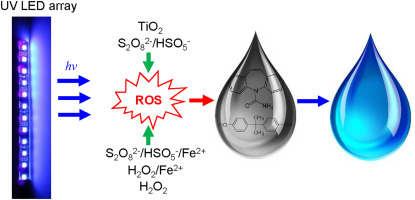Water Research ( IF 11.4 ) Pub Date : 2018-01-04 , DOI: 10.1016/j.watres.2017.12.079 Galina Matafonova , Valeriy Batoev

|
Over the last decade, ultraviolet light-emitting diodes (UV LEDs) have attracted considerable attention as alternative mercury-free UV sources for water treatment purposes. This review is a comprehensive analysis of data reported in recent years (mostly, post 2014) on the application of UV LED-induced advanced oxidation processes (AOPs) to degrade organic pollutants, primarily dyes, phenols, pharmaceuticals, insecticides, estrogens and cyanotoxins, in aqueous media. Heterogeneous TiO2-based photocatalysis in lab grade water using UVA LEDs is the most frequently applied method for treating organic contaminants. The effects of controlled periodic illumination, different TiO2-based nanostructures and reactor types on degradation kinetics and mineralization are discussed. UVB and UVC LEDs have been used for photo-Fenton, photo-Fenton-like and UV/H2O2 treatment of pollutants, primarily, in model aqueous solutions. Notably, UV LED-activated persulfate/peroxymonosulfate processes were capable of providing degradation in DOC-containing waters. Wall-plug efficiency, energy-efficiency of UV LEDs and the energy requirements in terms of Electrical Energy per Order (EEO) are discussed and compared. Despite the overall high degradation efficiency of the UV LED-based AOPs, practical implementation is still limited and at lab scale. More research on real water matrices at more environmentally relevant concentrations, as well as an estimation of energy requirements providing fluence-based kinetic data are required.
中文翻译:

紫外发光二极管通过高级氧化工艺降解水中有机污染物的最新进展:综述
在过去的十年中,紫外线发光二极管(UV LED)作为用于水处理目的的替代无汞紫外线源引起了广泛的关注。这篇评论是对最近几年(主要是2014年后)报道的有关应用UV LED诱导的高级氧化过程(AOP)降解有机污染物(主要是染料,酚,药物,杀虫剂,雌激素和氰毒素)的数据的综合分析,在水性介质中。使用UVA LED在实验室级水中使用基于TiO 2的非均相光催化方法是处理有机污染物的最常用方法。不同的TiO 2对周期性照明的影响讨论了基于纳米的结构和反应器类型对降解动力学和矿化的影响。UVB和UVC LED主要用于模型水溶液中,用于光芬顿,类光芬顿和UV / H 2 O 2污染物的处理。值得注意的是,UV LED活化的过硫酸盐/过氧一硫酸盐工艺能够在含DOC的水中降解。墙插效率,UV LED的能量效率以及每订单电能(E EO)的能量要求)进行了讨论和比较。尽管基于UV LED的AOP总体上具有较高的降解效率,但实际的实施仍然受到限制,并且处于实验室规模。需要对与环境相关的浓度更高的真实水基质进行更多研究,并提供基于能量密度的动力学数据来估算能量需求。











































 京公网安备 11010802027423号
京公网安备 11010802027423号